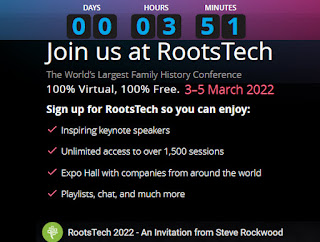RootsTech 2022 starts in a few hours. If there is anything positive that has come out of this pandemic, it is that all of us avid genealogists once again have access to the world's largest genealogy conference for free and from the comfort of our homes.
Not only do we get to save money on traveling (which leaves us with more money to spend on DNA testing), we'll also have access to their catalog of over 1500 sessions for a full year. And based on the availability of the RootsTech video archives (dating back to 2015) and the fact that the 2021 sessions are still online. We can take our time going through each of the sessions.
Given that we're still in the wild west of genetic genealogy, where new tools are constantly being developed and deployed. And there are several major companies for use to DNA test with (Ancestry.com, Familytreedna.com, 23andme.com, MyHeritage.com) and there are several websites and places where we can conduct our research. There is a lot of ground to cover. For those who may still be fairly new to DNA testing or researching, or even to RootsTech, it can be overwhelming.
I love that RootsTech provides the ability to add sessions to a playlist (and I've already filled mine), but I don't see an option to sort or organize the playlist or even to share my playlist with others. So I've quickly gone through and picked out some selections that others may want to begin with.
I've also added some suggestions to consider as you're watching the sessions.
RootsTech 2022 Information
There are over 1500 pre-recorded and live sessions that will be available for free all year.
In the pdf (link below), I’ve grouped them into sections and in a viewing order that may be helpful to follow:
Link to google document (with links) of sessions I suggest starting with.
RootsTech 2022 Home page | Main Stage | Calendar of live content
Lastly. here are things to remember as you’re searching for or watching the sessions:
- Take notes! Writing something down with a pen and paper (or even stylus/tablet) puts the information into long-term memory. So you’re not taking notes because you’re going to be quizzed later. It simply helps you retain the information.
- Put it into practice. Take a break between videos and jump over to your matches or records in your tree. Try out triangulation or DNA painter tools, or converting a paper document to digital pdf, etc.
- Take your time going through them. These sessions will be available to watch for a full year. Come back and re-watch to pick up items you may have missed.
- Look at the series page to see if there are more videos in the series.
- Read the description to see if there is a precursor or companion video you should watch.
- Download and view any accompanying materials (i.e. syllabus, presentation slides, etc).
- These are pre-recorded sessions. But listen for ways you can contact the presenters if you have follow-up questions. They may tell you to look for them in the virtual expo hall, the chat sessions, or even contact them via their public website or social media profiles.
- Watch different presenters even if they cover the same topic. You’ll learn different ways of doing the same methods. They’ll present the information with different visuals and analogies to help you learn the concepts.
- Look for the RootsTech presenters on Youtube or other sites. Some of the RootsTech sessions are brief and cover the basics. Once you’ve grasped the basics, look to see if there are other learnings that go more in-depth.
- Don’t forget to use both the written guides and videos available on all of the sites where you research and manage your tests and matches. Those sites offer in-depth learning tools.
Let me know in
the comments below which sessions you're looking forward to. Also come back and
let me know what you've learned and if it helped you break down any of your
brick walls!

Comments
Post a Comment